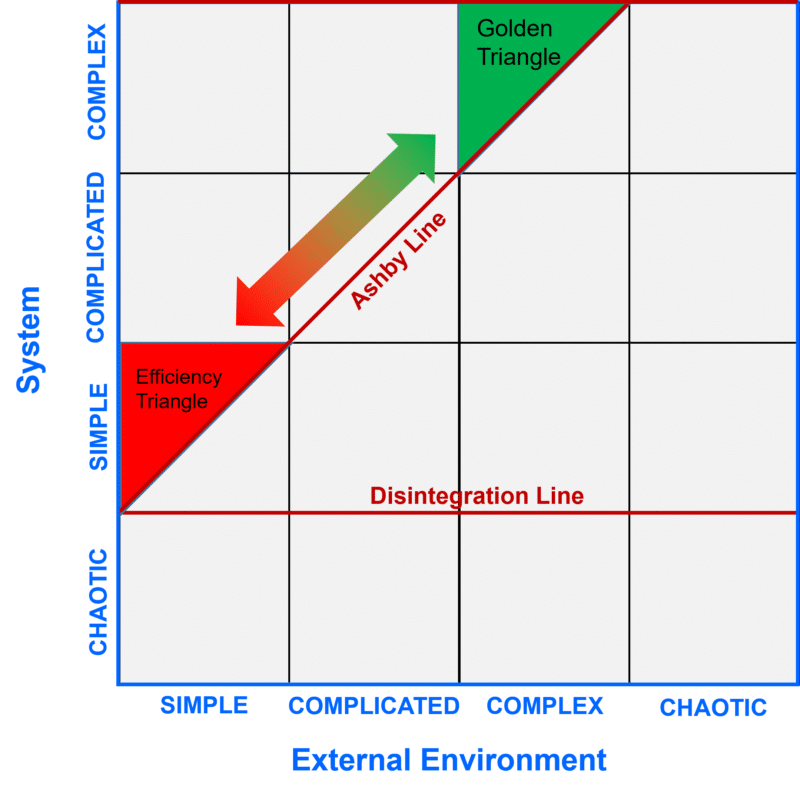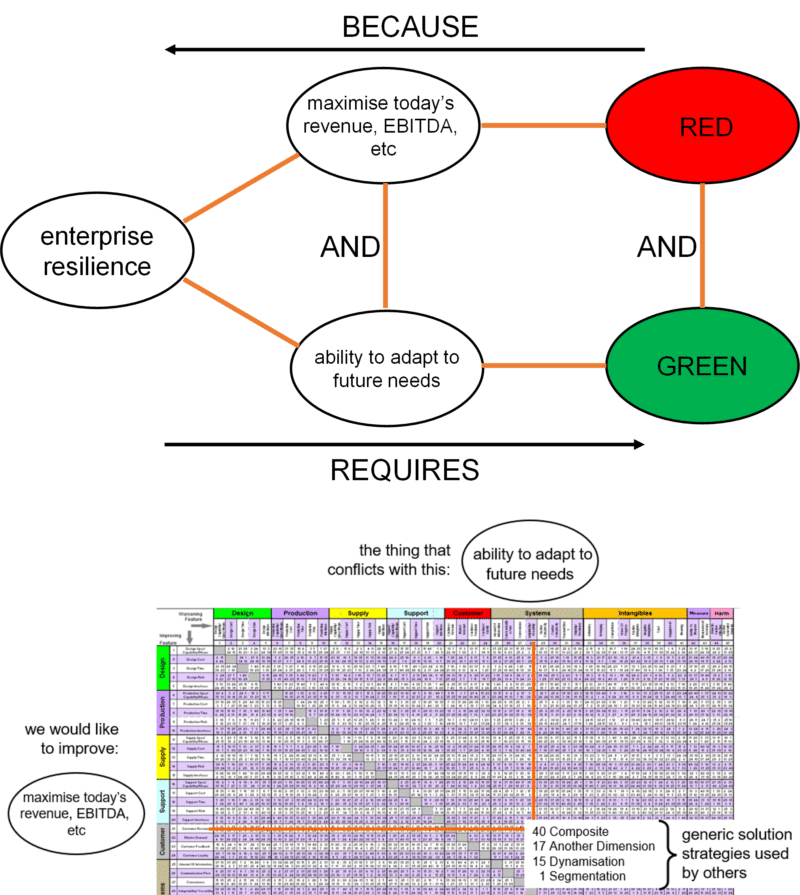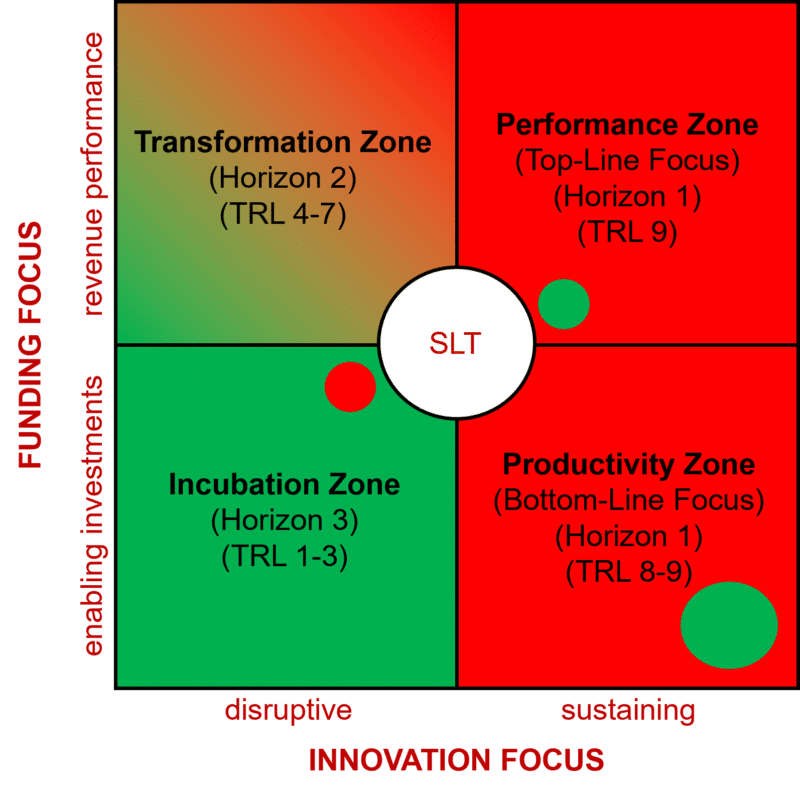I’ve spent a lot of time in the past couple of years talking to enterprises of various sizes about what might just be the dominant business contradiction of the times: the parallel need to maximise near-term operating efficiencies and ensure longer-term survival. The two sides of the contradiction have been encapsulated in Red-World and Green-World analogies. Red-World being all about the mindsets, operating philosophies, methodologies and tools required to deliver the simplification and standardisation necessary to maximise operating efficiencies. And Green World being all about those required to venture into the complex, chaotic unknown future, be able to make sense of it, and then ensure the future resilience of the enterprise. Here are the two world expressed in terms of the Complexity Landscape Model (CLM):

Essentially, enterprises need both Red and Green World capabilities. Which in turn means managing or, ideally, transcending the fundamental contradictions between the two. The simplest contradiction management strategy in effect segments Red World and Green World into two wholly separate entities. This is the Skunkworks model still pervasive in and around the aerospace industry: put all the Red people in one building to ensure the production of safe, standardised, efficient, follow-the-rules, profitable products, and put all the Green people in a completely separate building to do all of the confusion-ridden, going-boldly-where-no-one-has-gone-before, breaking of rules stuff. The big problem with this model is that it continues to be extremely difficult (and expensive) for the exciting new technologies to make the transition out from their Green origins and into their future Red revenue-generating home. In effect, the aerospace industry is able to ‘get-away’ with this difficulty because it is a mature industry with a very slow disruption cadence.
Faster moving industries that have tried the Skunkworks segmentation approach have usually failed to make it work for them. They need something more akin to Red/Green solutions that transcend rather than merely manage the contradiction. Here’s what the contradiction Matrix has to say about how others have successfully evolved these more effective solutions:

The fourth most frequently used strategy, Principle 1, Segmentation, takes us into the world of the 2015 Geoffrey Moore book, ‘Zone to Win’. On one level, the book describes a segmentation model that divides an enterprise into four domains rather than the two found in aerospace. Two of the four correspond directly to the Red-World/Green-World ends of the contradiction spectrum. Taking all four segments together produces a model that looks like this:

It is the third most frequently used solution strategy, Principle 15, Dynamisation (15A: ‘Allow an entity or system to change to achieve optimal operation under different conditions’), however, that takes us to the real essence of Zone To Win. It is one thing to segment Green and Red Worlds, quite another to be able to dynamically shift the emphasis and relative importance of the four zones according to the prevailing and emerging market conditions.
Most insightfully, I think, is Moore’s ‘Transformation Zone’, the place where, in effect, the enterprise must deal with the ‘D’ part of R&D. This is the TRL4-7 transition between Green and Red World, and as such, Moore recognises that this Zone only really gets switched on once either a disruptive threat emerges to jeopardise Red World’s Production Zone, or, if the leadership team are braver, the enterprise decides to proactively become the disruptor.
Moore’s Zoning model doesn’t incorporate the usual circle I’ve drawn in the middle of the 2×2 matrix, but because Zone To Win is written as a playbook for the Senior Leadership Team of an enterprise, it is the place where they sit. In effect, above the four zones, coordinating the transitions between each of them, shifting the relative resources each needs as market conditions shift, and, switching on the Transformation Zone as and when the disruptive threat or opportunity arises.
If there’s a failing to the book it is that, because it is written as a How-To guide for senior leaders, it fails to cover the ‘Why-To’ part of the story. Probably because Moore assumes that only the senior leaders need to worry about that part of the story. And that they’re the only people in the enterprise that ultimately need to know. Part of that knowledge being that disruptive times – whether proactively launched, or reactively responded to – are inherently traumatic to everyone, and probably more so the further down the hierarchy one goes. While I can see the traditional leadership logic of keeping bad news away from people, I also get to see the damage it causes. In many ways that’s why I’ve been evolving the whole Red-World/Green-World story: if a leader genuinely wishes to lead the team through a Hero’s Journey, better to equip them with the necessary skills and mindsets. People love change, they hate being changed. Too often, Red-World gets things done using Parent-Child management strategies, whereas Green-World understands that Heroism works far better when everyone is being treated as an Adult. And therefore knows why they’re there, and has the requisite autonomy to do what needs to be done. Why and when to be Red, and why and when to be Green.
